Exploring Leadership and Change in Organizational Behaviour
VerifiedAdded on 2020/03/28
|6
|1368
|145
AI Summary
The assignment titled 'Exploring Leadership and Organizational Change in Modern Enterprises' provides a comprehensive examination of leadership theories and their impact on organizational behavior, focusing on trait and behavioral approaches. It explores how these theories shape leadership practices within organizations, emphasizing the development and training of leaders through specific behaviors rather than inherent traits. The analysis extends to organizational change dynamics by differentiating between sustaining innovations, which improve existing products incrementally, and disruptive innovations that create new markets and value structures, as exemplified by Apple's iPod and Amazon's online bookstore. Cultural influences are also considered in how they affect leadership styles, employee motivation, and productivity within organizations. The assignment underscores the importance of a conducive work environment, effective communication, and talent development in fostering high-trust workplaces and retaining skilled employees.
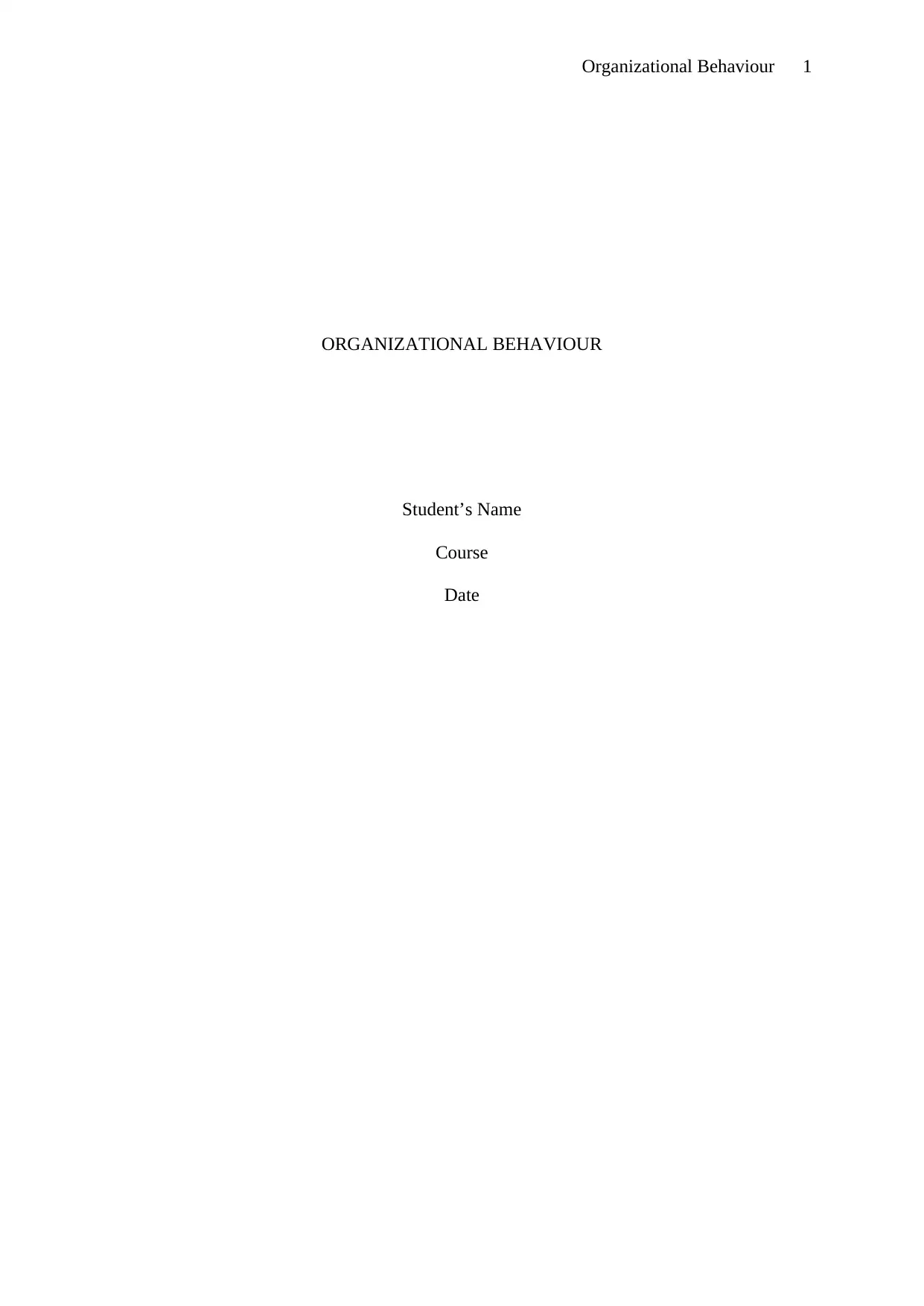
Organizational Behaviour 1
ORGANIZATIONAL BEHAVIOUR
Student’s Name
Course
Date
ORGANIZATIONAL BEHAVIOUR
Student’s Name
Course
Date
Paraphrase This Document
Need a fresh take? Get an instant paraphrase of this document with our AI Paraphraser
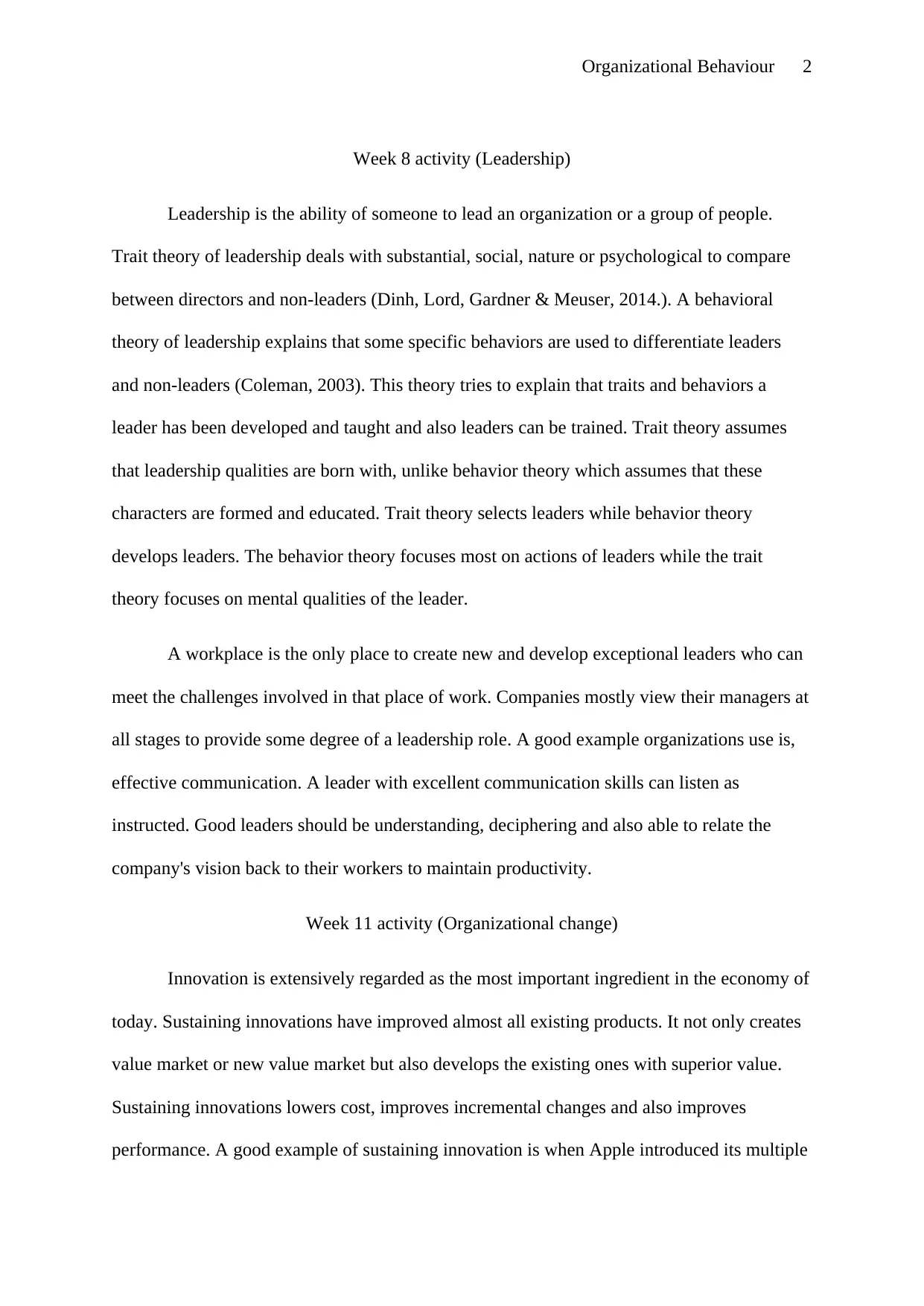
Organizational Behaviour 2
Week 8 activity (Leadership)
Leadership is the ability of someone to lead an organization or a group of people.
Trait theory of leadership deals with substantial, social, nature or psychological to compare
between directors and non-leaders (Dinh, Lord, Gardner & Meuser, 2014.). A behavioral
theory of leadership explains that some specific behaviors are used to differentiate leaders
and non-leaders (Coleman, 2003). This theory tries to explain that traits and behaviors a
leader has been developed and taught and also leaders can be trained. Trait theory assumes
that leadership qualities are born with, unlike behavior theory which assumes that these
characters are formed and educated. Trait theory selects leaders while behavior theory
develops leaders. The behavior theory focuses most on actions of leaders while the trait
theory focuses on mental qualities of the leader.
A workplace is the only place to create new and develop exceptional leaders who can
meet the challenges involved in that place of work. Companies mostly view their managers at
all stages to provide some degree of a leadership role. A good example organizations use is,
effective communication. A leader with excellent communication skills can listen as
instructed. Good leaders should be understanding, deciphering and also able to relate the
company's vision back to their workers to maintain productivity.
Week 11 activity (Organizational change)
Innovation is extensively regarded as the most important ingredient in the economy of
today. Sustaining innovations have improved almost all existing products. It not only creates
value market or new value market but also develops the existing ones with superior value.
Sustaining innovations lowers cost, improves incremental changes and also improves
performance. A good example of sustaining innovation is when Apple introduced its multiple
Week 8 activity (Leadership)
Leadership is the ability of someone to lead an organization or a group of people.
Trait theory of leadership deals with substantial, social, nature or psychological to compare
between directors and non-leaders (Dinh, Lord, Gardner & Meuser, 2014.). A behavioral
theory of leadership explains that some specific behaviors are used to differentiate leaders
and non-leaders (Coleman, 2003). This theory tries to explain that traits and behaviors a
leader has been developed and taught and also leaders can be trained. Trait theory assumes
that leadership qualities are born with, unlike behavior theory which assumes that these
characters are formed and educated. Trait theory selects leaders while behavior theory
develops leaders. The behavior theory focuses most on actions of leaders while the trait
theory focuses on mental qualities of the leader.
A workplace is the only place to create new and develop exceptional leaders who can
meet the challenges involved in that place of work. Companies mostly view their managers at
all stages to provide some degree of a leadership role. A good example organizations use is,
effective communication. A leader with excellent communication skills can listen as
instructed. Good leaders should be understanding, deciphering and also able to relate the
company's vision back to their workers to maintain productivity.
Week 11 activity (Organizational change)
Innovation is extensively regarded as the most important ingredient in the economy of
today. Sustaining innovations have improved almost all existing products. It not only creates
value market or new value market but also develops the existing ones with superior value.
Sustaining innovations lowers cost, improves incremental changes and also improves
performance. A good example of sustaining innovation is when Apple introduced its multiple
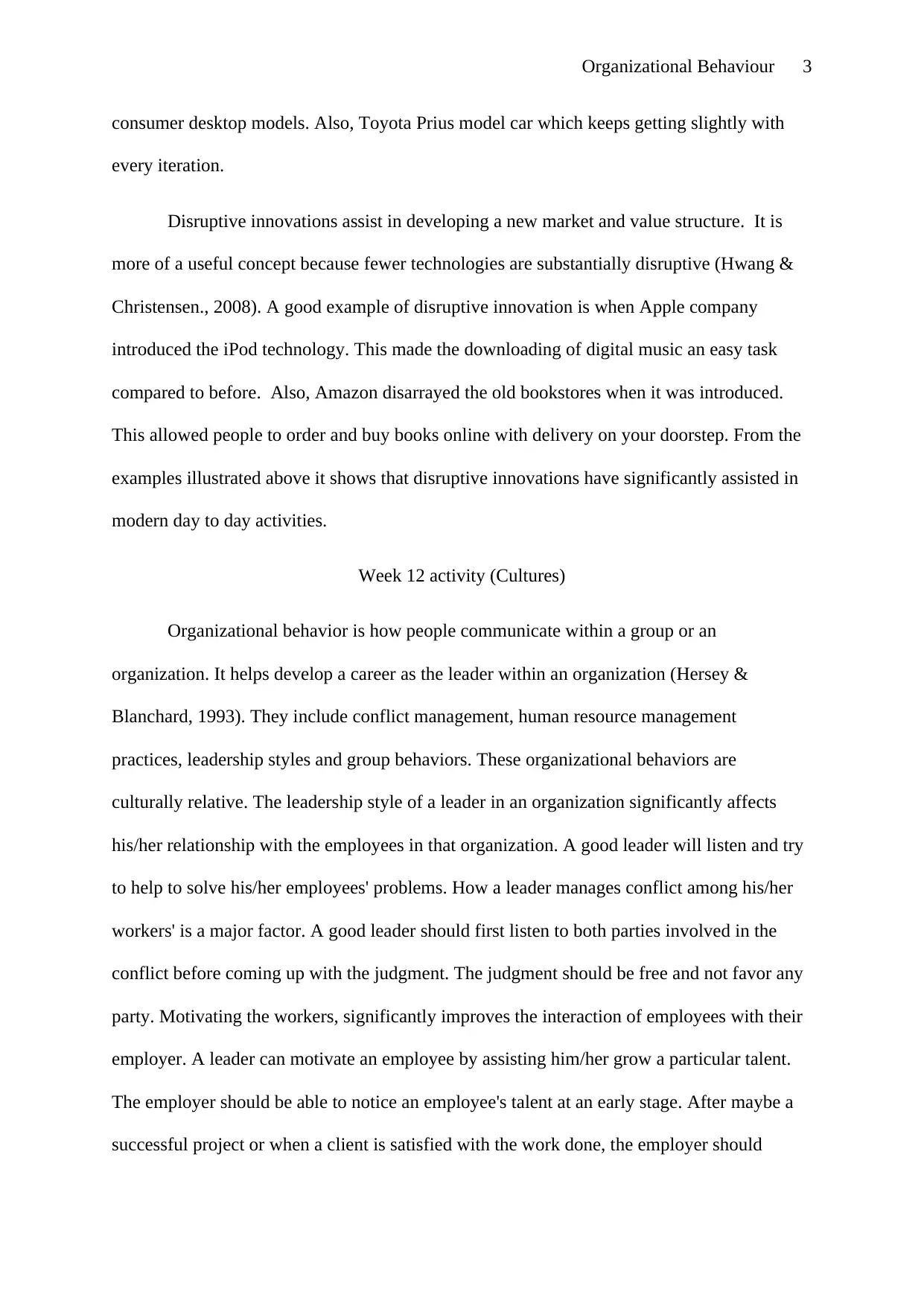
Organizational Behaviour 3
consumer desktop models. Also, Toyota Prius model car which keeps getting slightly with
every iteration.
Disruptive innovations assist in developing a new market and value structure. It is
more of a useful concept because fewer technologies are substantially disruptive (Hwang &
Christensen., 2008). A good example of disruptive innovation is when Apple company
introduced the iPod technology. This made the downloading of digital music an easy task
compared to before. Also, Amazon disarrayed the old bookstores when it was introduced.
This allowed people to order and buy books online with delivery on your doorstep. From the
examples illustrated above it shows that disruptive innovations have significantly assisted in
modern day to day activities.
Week 12 activity (Cultures)
Organizational behavior is how people communicate within a group or an
organization. It helps develop a career as the leader within an organization (Hersey &
Blanchard, 1993). They include conflict management, human resource management
practices, leadership styles and group behaviors. These organizational behaviors are
culturally relative. The leadership style of a leader in an organization significantly affects
his/her relationship with the employees in that organization. A good leader will listen and try
to help to solve his/her employees' problems. How a leader manages conflict among his/her
workers' is a major factor. A good leader should first listen to both parties involved in the
conflict before coming up with the judgment. The judgment should be free and not favor any
party. Motivating the workers, significantly improves the interaction of employees with their
employer. A leader can motivate an employee by assisting him/her grow a particular talent.
The employer should be able to notice an employee's talent at an early stage. After maybe a
successful project or when a client is satisfied with the work done, the employer should
consumer desktop models. Also, Toyota Prius model car which keeps getting slightly with
every iteration.
Disruptive innovations assist in developing a new market and value structure. It is
more of a useful concept because fewer technologies are substantially disruptive (Hwang &
Christensen., 2008). A good example of disruptive innovation is when Apple company
introduced the iPod technology. This made the downloading of digital music an easy task
compared to before. Also, Amazon disarrayed the old bookstores when it was introduced.
This allowed people to order and buy books online with delivery on your doorstep. From the
examples illustrated above it shows that disruptive innovations have significantly assisted in
modern day to day activities.
Week 12 activity (Cultures)
Organizational behavior is how people communicate within a group or an
organization. It helps develop a career as the leader within an organization (Hersey &
Blanchard, 1993). They include conflict management, human resource management
practices, leadership styles and group behaviors. These organizational behaviors are
culturally relative. The leadership style of a leader in an organization significantly affects
his/her relationship with the employees in that organization. A good leader will listen and try
to help to solve his/her employees' problems. How a leader manages conflict among his/her
workers' is a major factor. A good leader should first listen to both parties involved in the
conflict before coming up with the judgment. The judgment should be free and not favor any
party. Motivating the workers, significantly improves the interaction of employees with their
employer. A leader can motivate an employee by assisting him/her grow a particular talent.
The employer should be able to notice an employee's talent at an early stage. After maybe a
successful project or when a client is satisfied with the work done, the employer should
⊘ This is a preview!⊘
Do you want full access?
Subscribe today to unlock all pages.

Trusted by 1+ million students worldwide
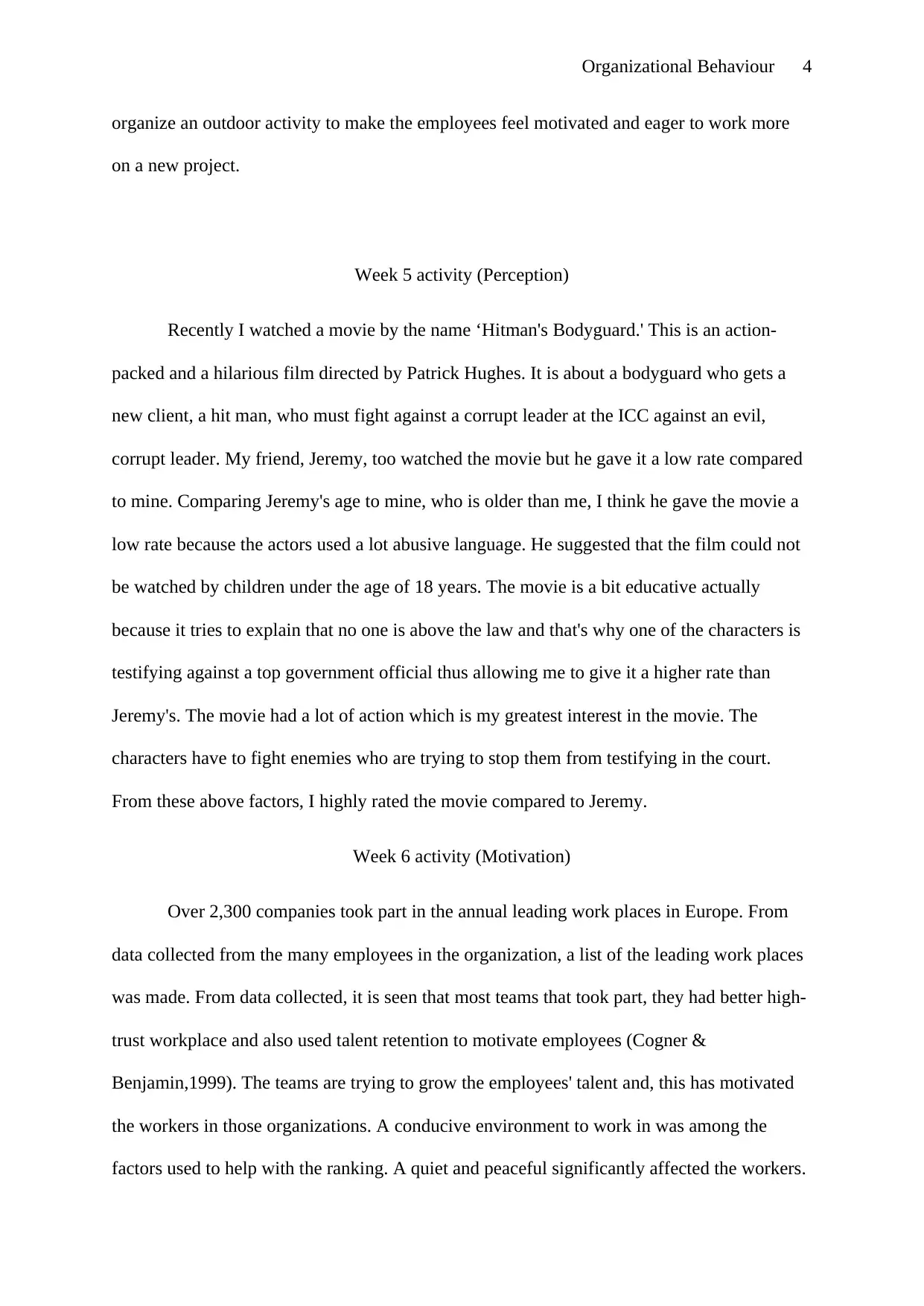
Organizational Behaviour 4
organize an outdoor activity to make the employees feel motivated and eager to work more
on a new project.
Week 5 activity (Perception)
Recently I watched a movie by the name ‘Hitman's Bodyguard.' This is an action-
packed and a hilarious film directed by Patrick Hughes. It is about a bodyguard who gets a
new client, a hit man, who must fight against a corrupt leader at the ICC against an evil,
corrupt leader. My friend, Jeremy, too watched the movie but he gave it a low rate compared
to mine. Comparing Jeremy's age to mine, who is older than me, I think he gave the movie a
low rate because the actors used a lot abusive language. He suggested that the film could not
be watched by children under the age of 18 years. The movie is a bit educative actually
because it tries to explain that no one is above the law and that's why one of the characters is
testifying against a top government official thus allowing me to give it a higher rate than
Jeremy's. The movie had a lot of action which is my greatest interest in the movie. The
characters have to fight enemies who are trying to stop them from testifying in the court.
From these above factors, I highly rated the movie compared to Jeremy.
Week 6 activity (Motivation)
Over 2,300 companies took part in the annual leading work places in Europe. From
data collected from the many employees in the organization, a list of the leading work places
was made. From data collected, it is seen that most teams that took part, they had better high-
trust workplace and also used talent retention to motivate employees (Cogner &
Benjamin,1999). The teams are trying to grow the employees' talent and, this has motivated
the workers in those organizations. A conducive environment to work in was among the
factors used to help with the ranking. A quiet and peaceful significantly affected the workers.
organize an outdoor activity to make the employees feel motivated and eager to work more
on a new project.
Week 5 activity (Perception)
Recently I watched a movie by the name ‘Hitman's Bodyguard.' This is an action-
packed and a hilarious film directed by Patrick Hughes. It is about a bodyguard who gets a
new client, a hit man, who must fight against a corrupt leader at the ICC against an evil,
corrupt leader. My friend, Jeremy, too watched the movie but he gave it a low rate compared
to mine. Comparing Jeremy's age to mine, who is older than me, I think he gave the movie a
low rate because the actors used a lot abusive language. He suggested that the film could not
be watched by children under the age of 18 years. The movie is a bit educative actually
because it tries to explain that no one is above the law and that's why one of the characters is
testifying against a top government official thus allowing me to give it a higher rate than
Jeremy's. The movie had a lot of action which is my greatest interest in the movie. The
characters have to fight enemies who are trying to stop them from testifying in the court.
From these above factors, I highly rated the movie compared to Jeremy.
Week 6 activity (Motivation)
Over 2,300 companies took part in the annual leading work places in Europe. From
data collected from the many employees in the organization, a list of the leading work places
was made. From data collected, it is seen that most teams that took part, they had better high-
trust workplace and also used talent retention to motivate employees (Cogner &
Benjamin,1999). The teams are trying to grow the employees' talent and, this has motivated
the workers in those organizations. A conducive environment to work in was among the
factors used to help with the ranking. A quiet and peaceful significantly affected the workers.
Paraphrase This Document
Need a fresh take? Get an instant paraphrase of this document with our AI Paraphraser
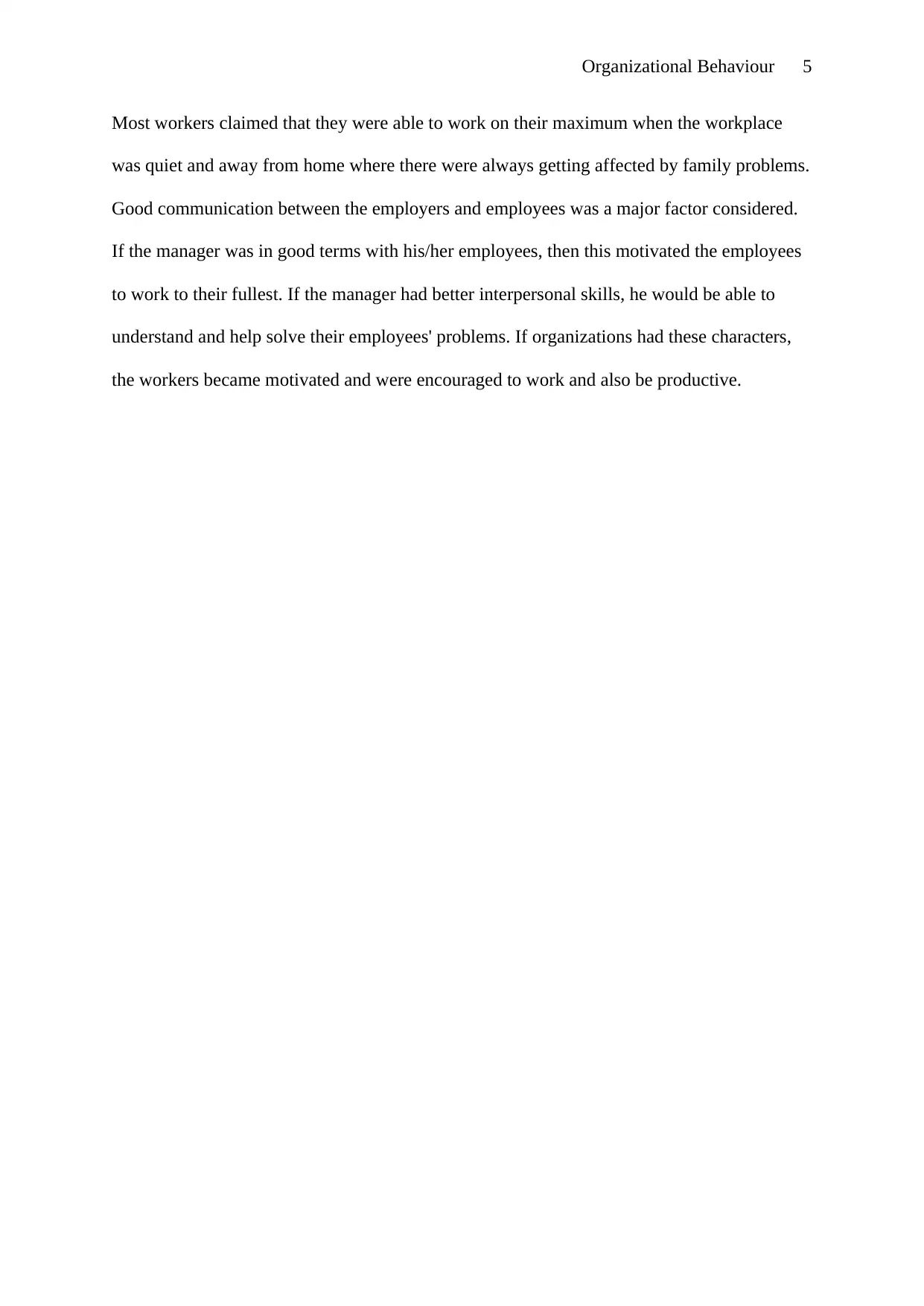
Organizational Behaviour 5
Most workers claimed that they were able to work on their maximum when the workplace
was quiet and away from home where there were always getting affected by family problems.
Good communication between the employers and employees was a major factor considered.
If the manager was in good terms with his/her employees, then this motivated the employees
to work to their fullest. If the manager had better interpersonal skills, he would be able to
understand and help solve their employees' problems. If organizations had these characters,
the workers became motivated and were encouraged to work and also be productive.
Most workers claimed that they were able to work on their maximum when the workplace
was quiet and away from home where there were always getting affected by family problems.
Good communication between the employers and employees was a major factor considered.
If the manager was in good terms with his/her employees, then this motivated the employees
to work to their fullest. If the manager had better interpersonal skills, he would be able to
understand and help solve their employees' problems. If organizations had these characters,
the workers became motivated and were encouraged to work and also be productive.
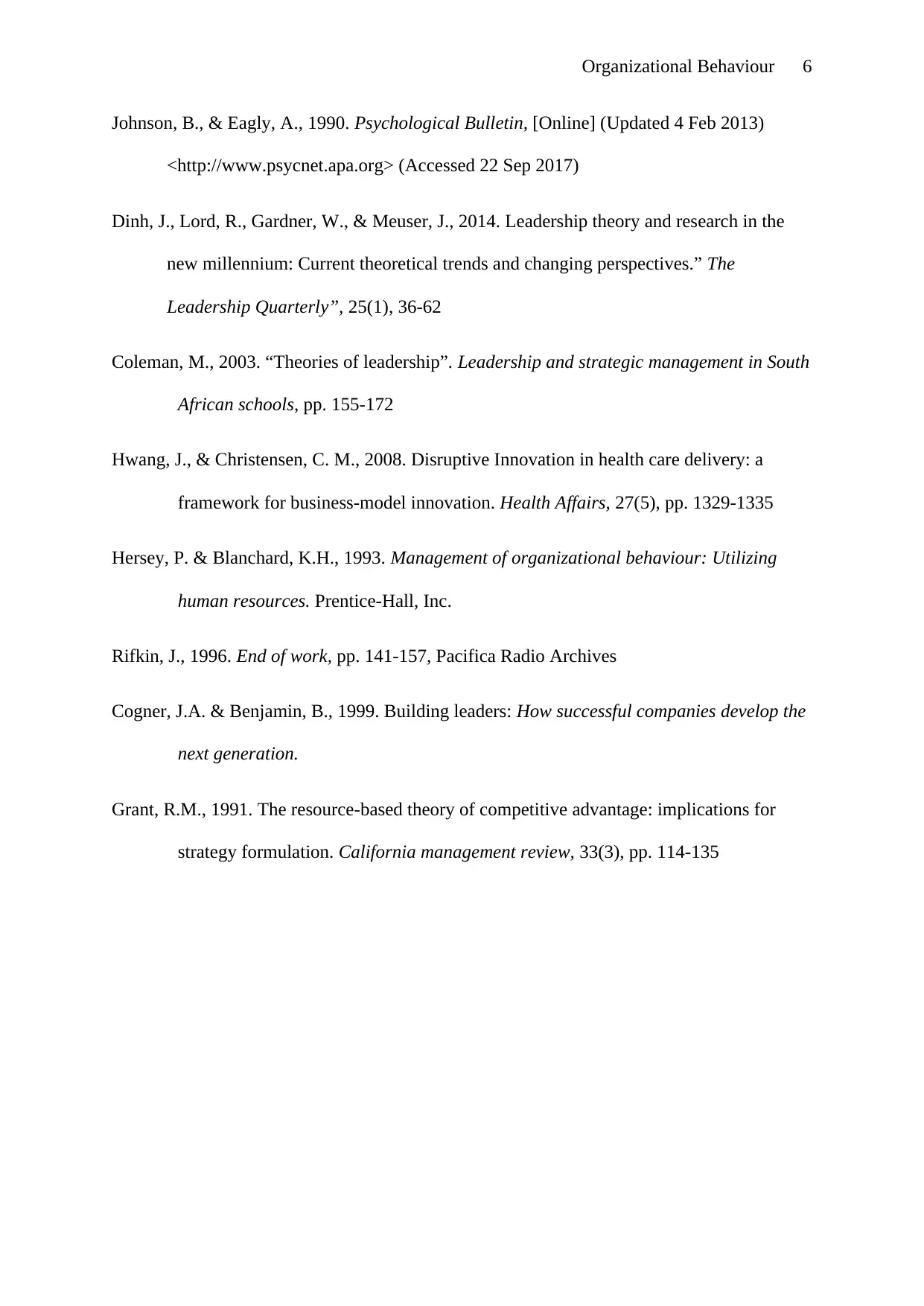
Organizational Behaviour 6
Johnson, B., & Eagly, A., 1990. Psychological Bulletin, [Online] (Updated 4 Feb 2013)
<http://www.psycnet.apa.org> (Accessed 22 Sep 2017)
Dinh, J., Lord, R., Gardner, W., & Meuser, J., 2014. Leadership theory and research in the
new millennium: Current theoretical trends and changing perspectives.” The
Leadership Quarterly”, 25(1), 36-62
Coleman, M., 2003. “Theories of leadership”. Leadership and strategic management in South
African schools, pp. 155-172
Hwang, J., & Christensen, C. M., 2008. Disruptive Innovation in health care delivery: a
framework for business-model innovation. Health Affairs, 27(5), pp. 1329-1335
Hersey, P. & Blanchard, K.H., 1993. Management of organizational behaviour: Utilizing
human resources. Prentice-Hall, Inc.
Rifkin, J., 1996. End of work, pp. 141-157, Pacifica Radio Archives
Cogner, J.A. & Benjamin, B., 1999. Building leaders: How successful companies develop the
next generation.
Grant, R.M., 1991. The resource-based theory of competitive advantage: implications for
strategy formulation. California management review, 33(3), pp. 114-135
Johnson, B., & Eagly, A., 1990. Psychological Bulletin, [Online] (Updated 4 Feb 2013)
<http://www.psycnet.apa.org> (Accessed 22 Sep 2017)
Dinh, J., Lord, R., Gardner, W., & Meuser, J., 2014. Leadership theory and research in the
new millennium: Current theoretical trends and changing perspectives.” The
Leadership Quarterly”, 25(1), 36-62
Coleman, M., 2003. “Theories of leadership”. Leadership and strategic management in South
African schools, pp. 155-172
Hwang, J., & Christensen, C. M., 2008. Disruptive Innovation in health care delivery: a
framework for business-model innovation. Health Affairs, 27(5), pp. 1329-1335
Hersey, P. & Blanchard, K.H., 1993. Management of organizational behaviour: Utilizing
human resources. Prentice-Hall, Inc.
Rifkin, J., 1996. End of work, pp. 141-157, Pacifica Radio Archives
Cogner, J.A. & Benjamin, B., 1999. Building leaders: How successful companies develop the
next generation.
Grant, R.M., 1991. The resource-based theory of competitive advantage: implications for
strategy formulation. California management review, 33(3), pp. 114-135
⊘ This is a preview!⊘
Do you want full access?
Subscribe today to unlock all pages.

Trusted by 1+ million students worldwide
1 out of 6
Related Documents
Your All-in-One AI-Powered Toolkit for Academic Success.
+13062052269
info@desklib.com
Available 24*7 on WhatsApp / Email
![[object Object]](/_next/static/media/star-bottom.7253800d.svg)
Unlock your academic potential
Copyright © 2020–2025 A2Z Services. All Rights Reserved. Developed and managed by ZUCOL.





